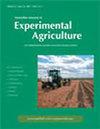Effect of whole cottonseed supplementation on energy and nitrogen partitioning and rumen function in dairy cattle on a forage and cereal grain diet
引用次数: 4
Abstract
The experimental objective was to determine the effect of adding whole cottonseed (WCS) to a forage and cereal grain diet on the energy and nitrogen balance and rumen function of lactating dairy cattle. Two experiments were carried out, a field experiment and an indoor metabolism experiment. In the field experiment, 50 lactating cows ~200 days in milk were randomly allocated to one of two groups (control or WCS). Cows were offered lucerne hay (morning) and ryegrass-based pasture silage (afternoon) in one group for 5 weeks. The hay and silage were placed on the ground in a bare paddock. Cows in each group were also individually offered cracked grain in a feed trough at 3 kg dry matter (DM)/cow.day at milking times. In addition, at milking times, cows in the WCS group were individually offered 2.7 kg DM/cow.day of WCS with their grain supplement. Samples of rumen fluid were collected from each fistula, ~4 h after grain feeding in the morning, of eight cows (four per group) on 1 day in each of the 5 weeks of treatment. In the metabolism experiment, immediately after the 5 weeks of feeding, 12 lactating cows, six from each treatment from the field experiment, were randomly selected and individually housed in metabolism stalls and fed the same diets for a 6-day energy and nitrogen balance study. Cows were fed at milking times (0700 and 1530 hours) and all feed offered and refused was weighed daily. All cows were offered 5.6 kg DM/cow.day of pasture silage, 4 kg DM/cow.day of lucerne hay and 3 kg DM/cow.day of cereal grain. In addition, cows in the WCS treatment group were offered 2.7 kg DM/cow.day of WCS with their grain supplement. In the metabolism study, adding WCS to the diet resulted in a greater energy intake, but there was no depression in energy digestibility. Whole cottonseed also increased nitrogen intake and nitrogen digestibility of the diet was increased from 62 to 75%, but the proportion of nitrogen in milk remained the same with a greater proportion of nitrogen appearing in body tissue. In the field experiment, supplementation with WCS did not alter rumen fluid ammonia-N or volatile fatty acid concentrations. Adding WCS did not affect three of the main classes of protozoa, based on size, within the two major orders of ciliate protozoa. The WCS did, however, reduce the levels of entodiniomorphs >200 µm diameter and holotrichs < 200 µm diameter, but these only account for a small number of the total protozoa present. Supplementation of a forage and grain-based diet with WCS improved the energy and protein content of the diet without any negative effects on rumen digestion and with a similar proportion of dietary energy and nitrogen appearing in milk. Over the summer period in winter-rainfall dairying areas in south-east Australia when pasture availability is limited and the diet is mainly comprised of forage and cereal grain fed at a level that is energy-limiting for maximum production, WCS can be and is used to supplement the diet to improve milk yield and profitability.饲粮中添加全棉籽对饲粮和谷物型奶牛能量、氮分配及瘤胃功能的影响
本试验旨在研究饲粮和谷物饲粮中添加全棉籽对泌乳奶牛能量氮平衡及瘤胃功能的影响。进行了田间试验和室内代谢试验。田间试验选用50头泌乳~200日龄奶牛,随机分为对照组和WCS组。每组饲喂紫花苜蓿干草(上午)和黑麦草类牧草青贮(下午),连续饲喂5周。干草和青贮饲料放在光秃秃的围场的地上。每组奶牛分别饲喂干物质(DM)为3 kg /头的碎粒饲料。每天挤奶的时候。此外,在挤奶时,WCS组奶牛每头单独饲喂2.7 kg干物质。在WCS中添加谷物。8头奶牛(每组4头)在5周的治疗中,每组1天,于晨饲后4 h从每个瘘管处采集瘤胃液。代谢试验中,在饲喂5周后,随机选取12头泌乳奶牛,每组6头,单独饲养于代谢栏内,饲喂相同的饲粮,进行为期6 d的能量氮平衡试验。在挤奶时间(0700和1530小时)饲喂奶牛,每天称重所有供饲和拒绝的饲料。每头奶牛饲喂5.6 kg DM。日牧草青贮,每头牛4 kg DM。每头牛饲喂3 kg干草料。谷物的日子。WCS处理组每头奶牛饲喂2.7 kg干物质。在WCS中添加谷物。在代谢研究中,饲粮中添加WCS会增加能量摄入,但不会降低能量消化率。全棉籽也提高了饲粮氮消化率,使饲粮氮消化率从62%提高到75%,但牛奶中氮的比例保持不变,身体组织中氮的比例更高。在田间试验中,添加WCS对瘤胃液氨氮和挥发性脂肪酸浓度没有影响。在纤毛虫原生动物的两个主要目中,根据大小,添加WCS对三个主要类别的原生动物没有影响。然而,WCS确实降低了直径小于200µm的内二胚和直径小于200µm的holotrichs的水平,但这些只占总原生动物的一小部分。在饲料和谷物基础饲粮中添加WCS可提高饲粮的能量和蛋白质含量,但对瘤胃消化没有负面影响,且牛奶中出现的饲粮能量和氮的比例相似。在澳大利亚东南部冬季降雨奶牛区的夏季,牧草供应有限,饲粮主要由饲料和谷物组成,饲料的能量水平限制了最大产量,WCS可以而且已经用于补充饲粮,以提高产奶量和盈利能力。
本文章由计算机程序翻译,如有差异,请以英文原文为准。
求助全文
约1分钟内获得全文
求助全文

 求助内容:
求助内容: 应助结果提醒方式:
应助结果提醒方式:


